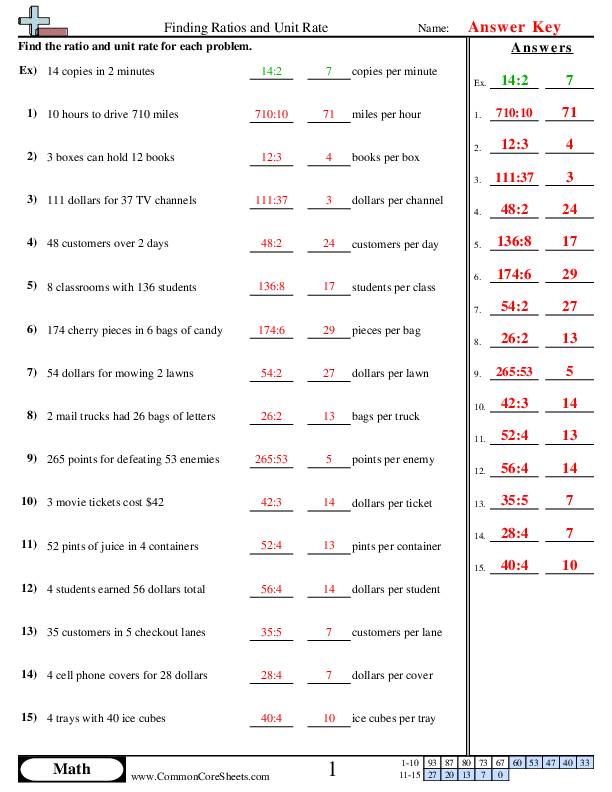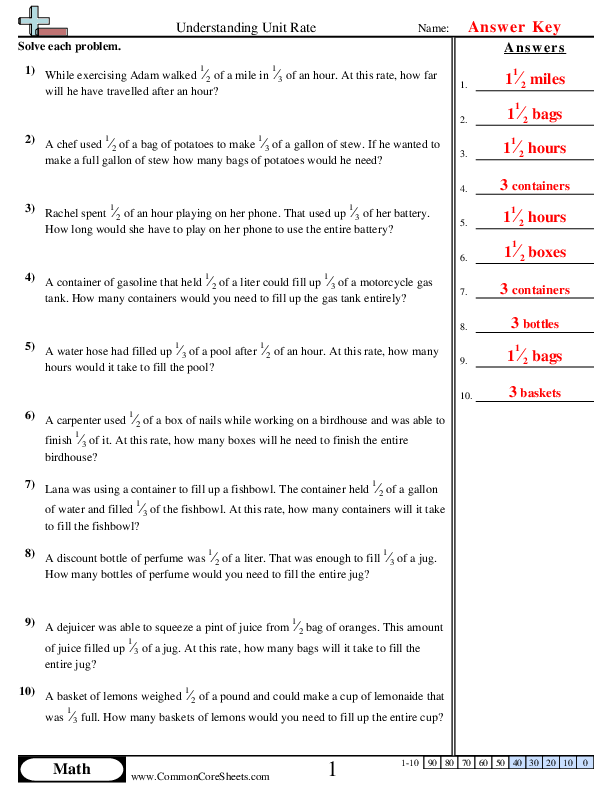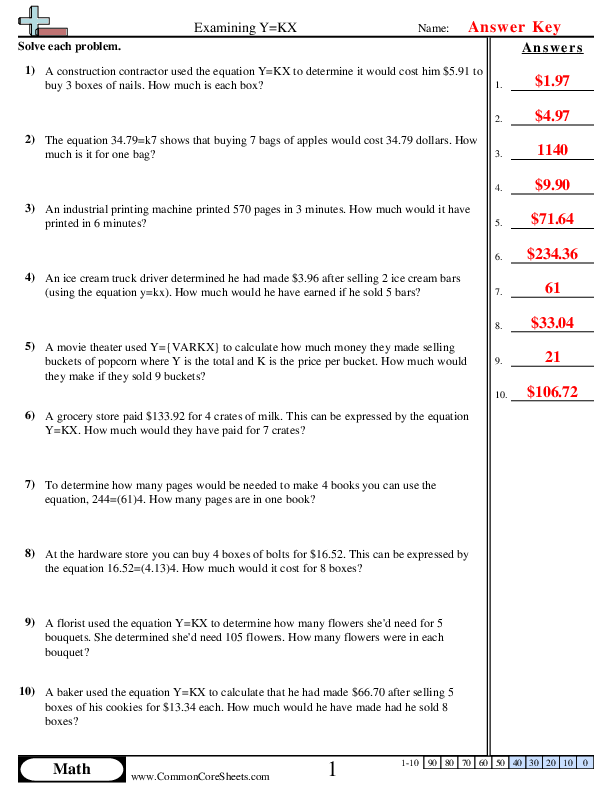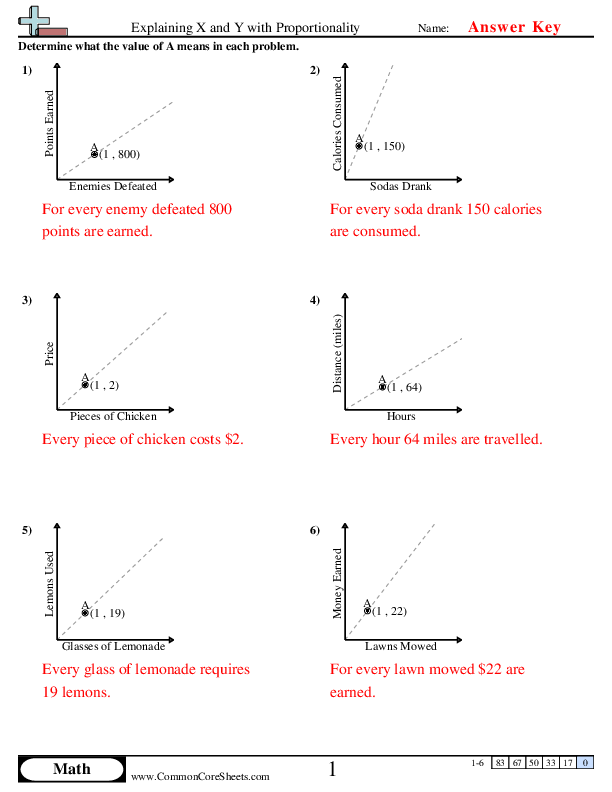Are you looking for the best ratio worksheets on the internet? Look no further - we have the perfect set of free ratio worksheets for you. Our ratio worksheets give students the opportunity to practice and reinforce their understanding of how to use ratios in real-world situations. Our worksheet includes examples, visual diagrams, and practice problems that will help your students gain a better understanding of how to properly work with ratios. With our ratio worksheets, you can be sure that your students are learning the concepts they need to succeed. So don't hesitate and try our free ratio worksheets today!
Browse Sheets By Problem Type
×
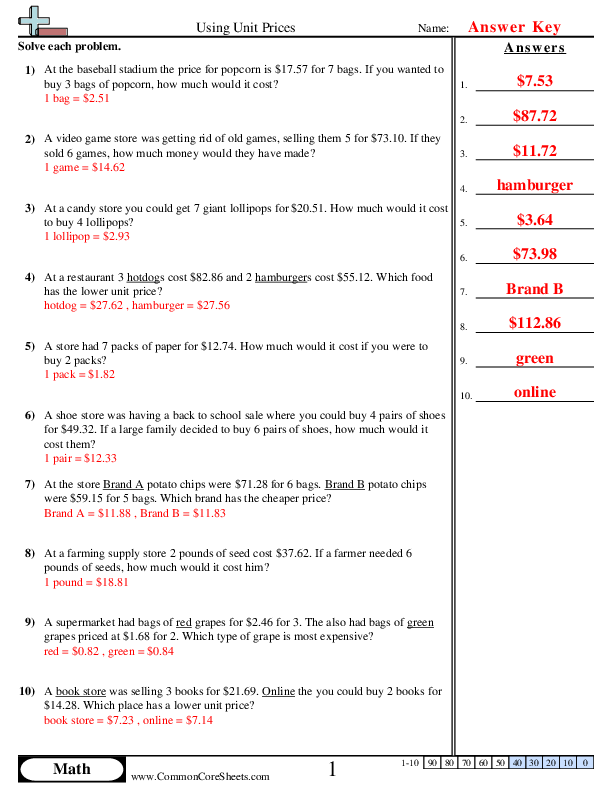
Using Unit Prices
6rp3b


×
Description:
"This worksheet is designed to enhance children's understanding of math through practical application, focusing on the concept of unit prices. It presents ten problems involving comparative shopping and budgeting scenarios, encouraging critical thinking and basic arithmetic skills. The worksheet can be customized for individual learning pace, converted into flash cards for interactive learning or employed in distance learning settings to suit unique educational needs."

×
Student Goals:
Understanding Unit PricesUpon completion of the worksheet, students should have a well-rounded understanding of unit prices. They will have confronted various real-life scenarios involving different items and quantities which will assist them in comprehending how the concept of unit price operates in everyday life. Students will be able to apply those concepts to new, similar situations they encounter.Comparative Shopping SkillsStudents will learn how to compare the prices of different brands or vendors of a given product in a market or store. They will gain the ability to decide which option provides the best value for money, enhancing their economic and financial awareness. This skill will be useful for efficient shopping and expenditure management in the future.Mathematical ProficiencyThe worksheet will enhance students' mathematical proficiency, specifically in operations involving division to determine unit prices. They will become more comfortable performing these operations and interpreting the results, strengthening their overall mathematical abilities and confidence.Decision-Making SkillsThe practice of deciding the better deal between different products or brands based on their unit prices encourages critical thinking and decision-making skills. This will assist students in making informed decisions, not only in a shopping context but also in other aspects of life that require similar analytical skills.Problem-Solving SkillsBy applying their knowledge of unit prices to real-world problems, students will develop essential problem-solving skills. These skills are not only applicable to mathematics but also other areas of life where they need to deduce solutions from given facts or conditions.Practical Transferable SkillsCompleting this worksheet will offer students practical, transferable skills. The ability to calculate and understand unit prices is useful both within and outside of a school context, equipping students with valuable tools they can use in their daily lives and in future careers.


Ratios and Unit Rates
6rp3b


×
Description:
"This worksheet is designed to teach children about the concept of ratios and unit rates in math. It contains 15 problems involving various contexts such as classrooms, CDs, game points, eating speed, ticket prices, earnings, snowfall, juice containers, TV commercials, and candy bags. Ideal for distance learning, its interactive format is customizable and can easily be converted into flash cards for convenient learning."

×
Student Goals:
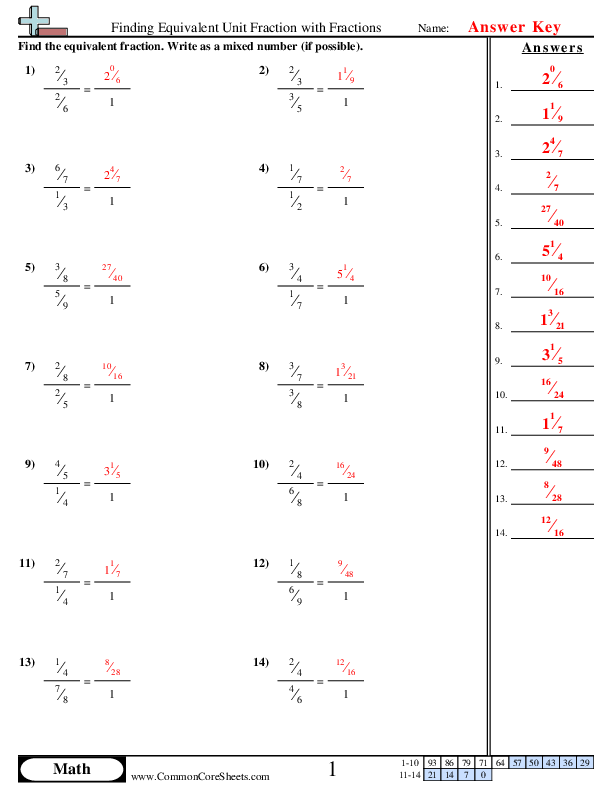
Finding Equivalent Unit Fraction with Fractions
7rp1


×
Description:
"This worksheet is designed to teach children about equivalent unit fractions in math. It contains 14 problems which introduce the concept of finding equivalent fractions and fosters critical thinking skills. Tailored for a customizable learning experience, this resource can be converted into flash cards for hands-on practice or utilized in distance learning settings. An essential tool for mastering fractions."

×
Student Goals:
Understanding Unit FractionsUpon completing the worksheet, students should have developed a grasp on the concept of unit fractions. Essentially, they should understand that a unit fraction is a fraction with a numerator of one. This foundational knowledge is critical in the study of more complex math topics as they advance in their studies.Recognizing Equivalent FractionsAnother achievement students should realize after successfully finishing this worksheet includes the ability to recognize equivalent fractions. This ability enhances numerical flexibility and allows students to manipulate numbers more effectively. Through the constant practice of such problems, students are expected to identify equivalent fractions with ease, thus improving mathematical agility.Discerning Non-Equivalent FractionsContrary to identifying equivalent fractions, students should also swiftly discern fractions that aren't equivalent after the completion of the worksheet. This proficiency in distinguishing non-equivalent fractions breeds confidence in dealing with mathematics problems that require quick and accurate identification of relationships between fractions.Solving Mathematical ProblemsAfter finishing the worksheet, students should be able to solve mathematical fraction problems more efficiently. They should be equipped with the problem-solving skills needed to approach math tasks and should be on their way to mastering the ability to apply these skills systematically in order to arrive at the most reasonable solution.Improving Mathematical Language UnderstandingCompleting the worksheet also improves students’ mathematical language understanding. They should be able to comprehend and apply mathematical terms, such as numerator, denominator, and equivalent, in a proper context. Hence, students are exposed to the necessary terminology that will likely be used throughout their mathematical education journey.Enhancing Numerical ReasoningFinally, students should be able to enhance their numerical reasoning skills after completing this worksheet. They should acquire the capability of thinking logically and analytically, making connections among mathematical ideas, and applying the appropriate strategies to solve fraction-related problems.


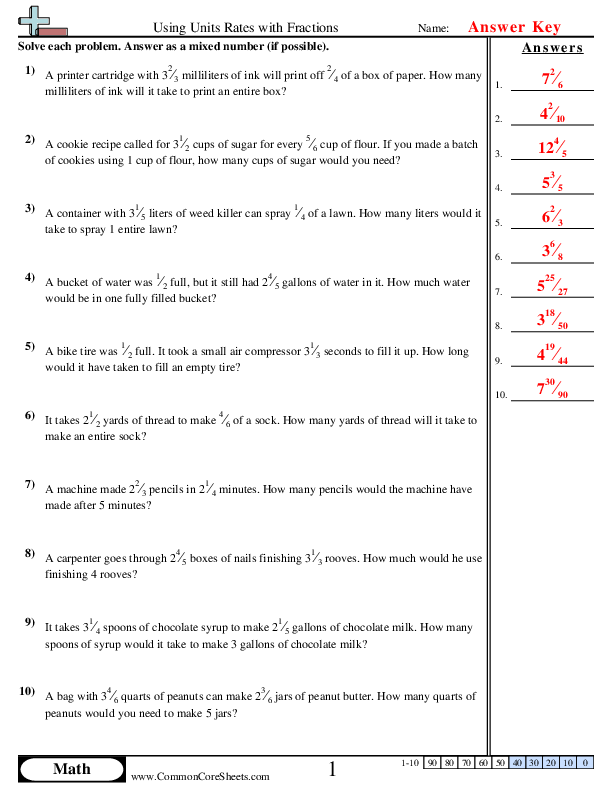
Using Unit Rates with Fractions
7rp1


×
Description:
"This worksheet is designed to enhance children's proficiency in math, specifically in using unit rates with fractions. Comprising of 10 hands-on problems, it provides scenarios involving various practical applications, such as measuring time, volume, and distance. Customizable to meet individual learning requirements, it can also be converted into flash cards for engaging study sessions or adapted for distance learning to facilitate continuous education at home."

×
Student Goals:
Understanding of Fractions and Unit RatesAfter completing these worksheet exercises, students should have significantly developed their understanding of fractions and unit rates. This understanding is not just in theoretical terms but in practical, real-world application scenarios as presented in the problems. They will be able to interpret and manipulate fractions in different contexts, gaining knowledge that is vital in both further mathematical studies and in daily life.Problem Solving AbilitiesStudents will have sharpened their problem-solving abilities by working through each task. The problems provided will challenge students to think critically about the provided scenario and figure out how to solve for the unknown. This analytical approach fosters the skills necessary in numerous future encounters, both scholastically and professionally.Enhance Critical ThinkingThese exercises will enable children to enhance their critical thinking abilities. The situations presented in the questions require a thoughtful analysis to resolve. Therefore, the sheet will be a tool for expanding strategic contemplation abilities in real-world situations, as well as complex mathematics.Real-World Math ApplicationHaving gone through the ten problems, the students will have experienced fractional scenarios based on real-life instances. They should now be capable of taking the abstract principles learned in class and applying them accurately to situations that they might encounter in daily life. Such an ability is crucial as it bridges the gap between theory learned and its use in the outside world.Time Management SkillsBy working through the math problems in this worksheet, students also get to improve their time management skills. Each problem requires a certain level of concentration and time commitment, and being able to balance this is a skill that students will find helpful in their future academic endeavors.Increased Confidence with MathSuccessfully navigating through this challenging, relatable, yet educational worksheet will imbue the student with increased confidence in handling mathematics problems, particularly involving fractions and unit rate. This can boost their overall interest in the subject and motivate them to tackle more complex problems in future.


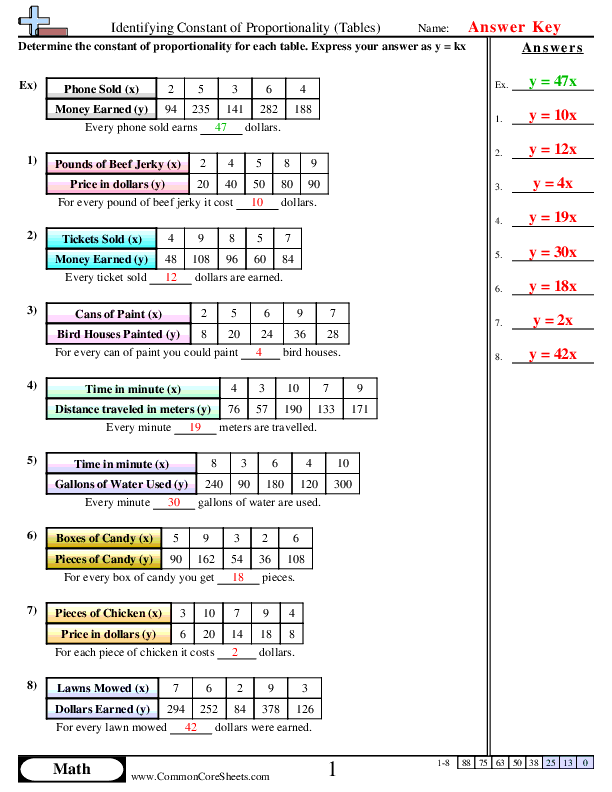
Constant of Proportionality (tables)
7rp2b


×
Description:
"This worksheet is designed to help children understand the concept of proportionality through real-life examples. It presents 8 diverse problems, from lemonade preparation to video game scores, testing kids on identifying the constant of proportionality in tables. In a fun, engaging format, it's versatile enough for any learning environment - customize for individual needs, convert to flash cards, or use in distance learning to enhance students' grasp of this essential math topic."

×
Student Goals:
Understanding Constant of ProportionalityUpon completion of this worksheet, students will have enhanced their understanding of the constant of proportionality. This key concept in mathematics, which is the consistent relationship between two variables, forms the basis for proportional reasoning. Mastering this skill will help students in comparing different scenarios, understanding rates and ratios, and solving practical everyday problems.Application in Real-World ScenariosThrough different practical problems, students will learn to apply their mathematical knowledge to real-world situations. By relating the concepts to familiar settings such as sales of items and measurements, students will be better able to comprehend the relevance and importance of constant of proportionality in everyday life situations.Problem Solving SkillsThis worksheet is designed to improve students' problem-solving abilities. Pupils will hone their skills to interpret tables, identify constants, and form mathematical relationships between different quantities. They will become adept at extracting vital information from given data, which is a valuable skill in tackling complex mathematical problems and in critical thinking.Mathematical Reasoning AbilityStudents will demonstrate growth in their mathematical reasoning abilities. This worksheet aims to make students more comfortable with proportional relationships, assisting them to form vital connections between different mathematical concepts. It will cultivate a deeper understanding of the wider mathematical framework.Preparation for Advanced Math ConceptsBy completing this worksheet, students will be better equipped for more advanced math concepts. Understanding the constant of proportionality is a fundamental building block for higher-level mathematics. This knowledge lays a strong foundation for topics like algebra, statistics, and calculus, setting students on a confident path to tackle more advanced studies.Improved Computation SkillsThe worksheet aids in honing the computation capabilities of students. They would get ample practice in multiplying and dividing numbers while finding the constant of proportionality from given data sets. It helps in achieving fluency in basic mathematical operations, improving their speed and precision.


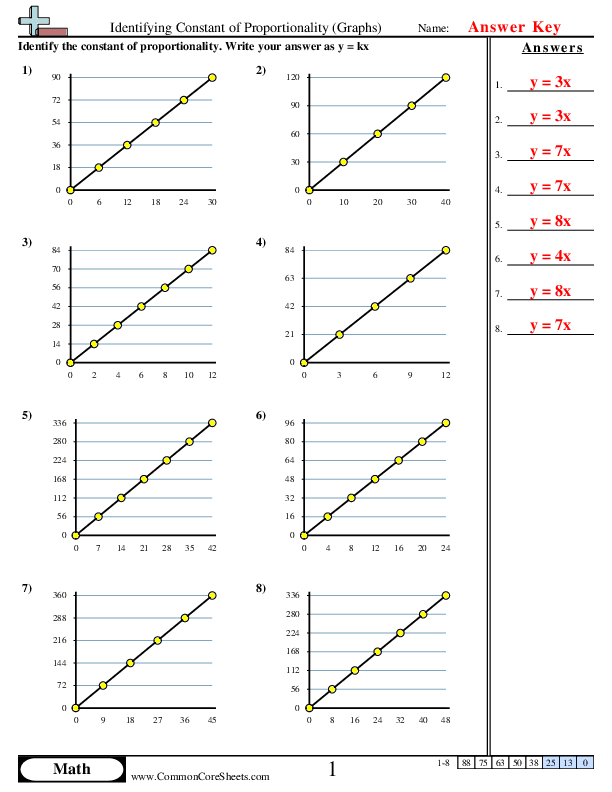
Constant of Proportionality (Graphs)
7rp2b


×
Description:
"This worksheet is designed to aid in mastering the concept of identifying the Constant of Proportionality in graphs in Math. Containing 8 engaging problems, it fosters an interactive learning experience for children. Notably, this adaptable worksheet can be customized according to individual needs, converted into flashcards for enhanced learning, or seamlessly incorporated into distance learning programs."

×
Student Goals:
Conceptual UnderstandingAfter completing the worksheet, students should have a solid understanding of the concept of the constant of proportionality in mathematics. They will be able to identify this constant in various graphical representations, fostering their ability to associate graphical patterns with mathematical concepts.Problem-Solving SkillsFurthermore, this worksheet will enhance students' problem-solving skills. They will learn how to work through complex problems involving constants of proportionality in graphs. This further nurtures their analytical thinking, a crucial skill not only in math but in all scientific subjects.Real-World ApplicationsUpon completion, students would be better poised to apply what they've learned to real-world scenarios. Constants of proportionality appear frequently in real-life situations, such as in calculations relating to speed, distance and time, among others. Students will, therefore, be better equipped to respond to math-related problems they encounter in everyday scenarios.Foundational Skill EnhancementThe worksheet will help students to solidify foundational math skills. Concepts like the constant of proportionality can be basis for learning more complex topics in mathematics. Mastering this concept would therefore give students a headway as they progress in their math learning journey.Interpreting GraphsCompletion of the worksheet would also mean that students are more proficient in interpreting graphs, a critical ability in many areas of study beyond math, including science and economics. They will be able to understand and interpret various forms of graphical data, a skill increasingly important in today's data-driven world.Time ManagementFinally, by working on the eight problems on this worksheet, students will subtly enhance their time management skills. They will learn how to strategically solve each problem within a reasonable time frame, an invaluable capability in timed tests and examinations.


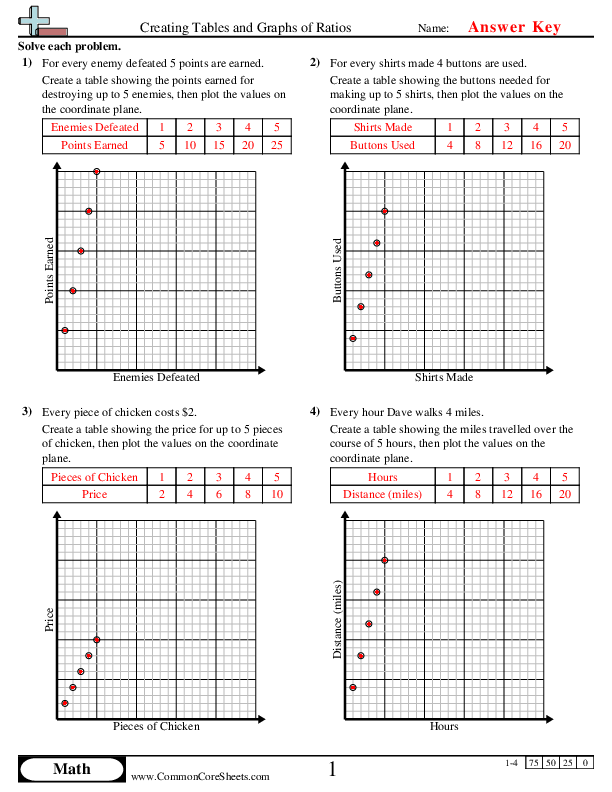
Creating Tables and Graphs of Ratios
6rp3a


×
Description:
"This worksheet is designed to teach children the concept of ratios through practical problem-solving exercises. It contains four interactive math problems that require creating tables and graphs using provided real-life scenarios. The worksheet can be personalized to suit individual learning needs, used as flash cards for easy memorization, or incorporated into distance learning curriculum. It offers an engaging way to build fundamental math skills."

×
Student Goals:
Understanding RatiosUpon completing the worksheet, students should have a solid understanding of ratios and their practical application. They will have hands-on experience with creating ratio tables, allowing them to visually grasp the proportional relationship between a pair of numbers. This fundamental knowledge will make subsequent topics easier to understand, such as rates, fractions, and percentages.Plotting on Coordinate PlaneStudents should be proficient in plotting points on a coordinate plane, a vital skill they will continually need throughout their mathematical education. They will gain experience in transforming data from ratio tables into graphs. This will lay the foundation for future studies in graphing, data analysis, and spatial thinking.Real World ApplicationsStudents should have the ability to apply the concept of ratios to real-world scenarios. The worksheet provides practical examples related to everyday life, like shopping and gaming, making the abstract concept of ratios more tangible and relatable. This meet should lead students to realize the value of math in daily situations, ultimately instilling a more positive attitude towards the subject.Problem SolvingThe worksheet should enhance students’ problem-solving skills. By provided problems of varying complexity, it will challenge students to think critically and devise an effective approach to finding solutions. This experience should improve their capacity to tackle an array of mathematical problems.Conceptual UnderstandingFinally, students should develop a deep, conceptual understanding of the relationship between quantities. The process of creating ratio tables and graphs takes them beyond just memorizing procedures and moves towards understanding why those procedures work. This kind of understanding is crucial for learning higher-level math concepts in the future.



